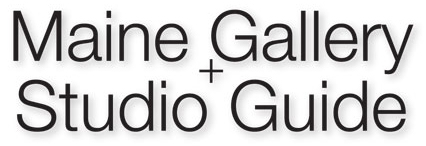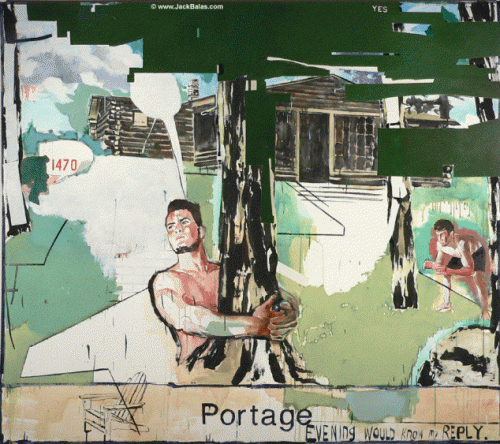
The University of Maine Museum of Art, located at 40 Harlow Street in downtown Bangor, opens four new exhibitions in September. UMMA is open Tuesday-Saturday from 10 am – 5 pm and brings modern and contemporary art to the region, presenting approximately 12 original exhibitions each year. UMMA’s fall shows open to the public on September 15 and run through December 30, 2017. Admission to the Museum of Art is free in 2017 thanks to the generosity of Deighan Wealth Advisors.
JACK BALAS: MAINE AND AGAIN
September 15 – December 30, 2017
Maine and Again, features over forty works by painter Jack Balas, who lives and works in Arizona and Colorado. The UMMA exhibition is the largest assembly of the artist’s works to date. Balas’s works, principally watercolor on paper and oil on canvas, are featured in a wide range of sizes including small compositions, multi-paneled paper pieces and several large canvases.
For nearly twenty years the depiction of athletic, youthful men, primarily of the all-American type, has been a focus of Balas. The artist’s buff subjects, some of whom seem to have just finished a gym session, offer a counterpoint to the proliferation of images of women throughout art history. These images of idealized masculinity celebrate the virility and wished-for invincibility of youth. Balas’s male subjects, at this particular stage of their lives, are full of desires, confidence, and hope. They possess an optimism and vitality as yet unfettered by the pressures of life.
Central to Balas’s creative process is the layering of seemingly disparate elements and painting styles within each work to create a fertile ground for contemplation. For example, in ZEITGEIST (#1207), we are left to ponder the relationship between a realist depiction of a muscular young boxer, a hastily-rendered outline of Mickey Mouse, thought bubbles with hand-drawn text, and a circular pool of bright green paint. Balas’s practice of journaling and story-telling is evident in the hand-drawn scrawled text and poetic passages that weave their way through many of the paintings.
The exhibition includes a selection of images that retell the artist’s adventures touring Maine as a young man in the 70s. Balas captures the lure of Maine’s varied landscape and creatures, as well as memorable moments for him such as meeting Andrew Wyeth, exploring coastal fishing villages, and hiking to the summit of Mt. Katahdin.
Maine and Again–a mid-career survey of sorts–features a number of just-completed works that are his largest canvases to date. Portage (Evening Would Know My Reply)(#1470), an 80 x 90-inch work from 2017, highlights the pleasures of summer. The artist has juxtaposed a painting of a log cabin, a linear drawing of an Adirondack chair, and two shirtless guys: one hugging a pine tree, the other crouched down in a game of catch. The cohabitation of Balas’s imagery ignites curiosity and sends the viewer on a search for meaning.
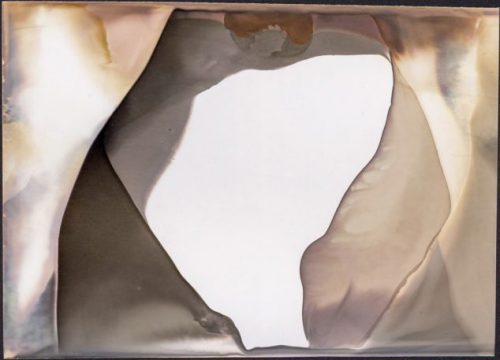
TRACES: AMY THEISS GIESE & KELIY ANDERSON-STALEY
September 15 – December 30, 2017
Traces features the works of Amy Theiss Giese and Keliy Anderson-Staley, two photographers whose processes and images question deep-rooted conceptions on what constitutes a photograph. Both photographers have not used camera or lens to create these abstract compositions. Their process of applying and manipulating photo chemicals, and the resulting final images, may be more akin to the language of painting. The splatters, drips, blooms, and marks in these assorted works are not unlike the movement and gestural brushwork seen in Abstract Expressionist canvases, particularly notable in Action Painting and Color Field.
Giese and Anderson-Staley’s work methods necessitate a keen understanding of the fleeting nature of photographic chemicals, darkroom techniques, and materials. However, of equal importance to their processes is the sheer delight of experimentation. A creative fearlessness and willingness to embrace uncertainty is essential in realizing these evocative works. The imagery invites innumerable associations including mutable landscapes, networks, organisms, and micro/macro worlds.
Anderson-Staley resides in Houston, Texas and creates works using a wet-plate collodion tintype process—the origins of which are rooted in photography’s early history. Giese, who is based in Boston, Massachusetts, creates her images by using black and white darkroom chemistry on both silver gelatin and chromogenic papers.
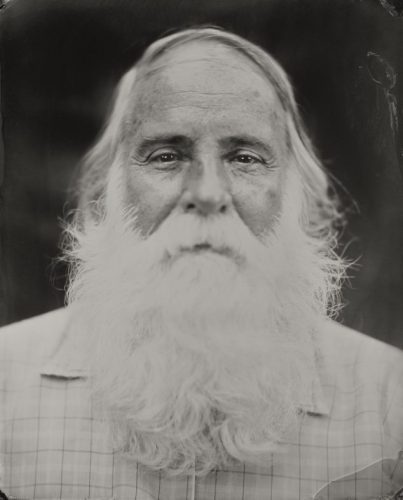
KELIY ANDERSON-STALEY: TINTYPE PORTRAITS
September 15 – December 30, 2017
Houston-based photographer Keliy Anderson-Staley has made thousands of portraits that record the diversity of American faces. The wall installations, arranged in grids, consist of portraits of individuals and couples. The photographer states, “Each individual in this series—identified only by a first name—defiantly asserts his or her selfhood, resisting any imposed or external categorizing system we might bring to these images.” Anderson-Staley’s images exhibit the alluring surfaces and distinctive tonality characteristic of the tintype process. Another unique aspect of her portraits is that some facial features of the subjects are sharp, while others are out of focus. Adding to the drama are the darkened, rounded edges that frame the compositions. Anderson-Staley focuses on individuals from all walks of life and highlights our uniqueness, as well as the interconnectedness of humanity.
Anderson-Staley creates images using the wet-plate collodian tintype process, made with chemistry mixed according to nineteenth-century recipes. She coats blackened aluminum with collodian and then submerges them in silver nitrate to become light sensitive. The portraits are created using a wooden view camera with antique brass lenses. Exposures range between four and 20 seconds and require the sitters to remain motionless. The plates are then developed with ferrous sulfate and fixed with potassium cyanide. Anderson-Staley keeps the history of the medium alive by exploring these early photographic processes, all while creating works that advance photography’s contemporary relevance and discourse.
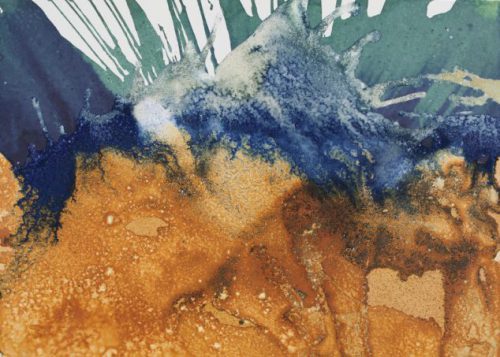
MEGHANN RIEPENHOFF: LITTORAL DRIFT NEARSHORE
September 15 – December 30, 2017
Meghann Riepenhoff exhibits a selection of camera-less images created in 2017, that record the essence of nature in its most elemental and fluctuating states. Riepenhoff works primarily in cyanotype, a process explored by Anna Atkins and other photographic pioneers in the 1840s. As is characteristic with this early photographic process, the artist has hand-coated watercolor paper with light-sensitive chemicals. What is unique to Riepenhoff’s process is that these works, often of considerable size, are created on location in a variety of natural environments. The paper is brought to sites where it is exposed to ocean waves, sections are buried in the sand, submerged in tidal pools, and draped over limbs in the rain. The process is both performative and physical as Riepenhoff collaborates with natural forces to create these striking works.
The cyanotype takes on a monumental presence in Littoral Drift Nearshore #516 (Bainbridge Island, WA 04.27.17), a large-scale composition created specifically for the UMMA exhibition. This immersive work, spanning ten feet, consists of twenty components joined together to convey the energy of undulating waves captured in a range of deep blues. Like the evolution of natural environments, Riepenhoff’s images continue to change over time—the surfaces are not fixed as in traditional darkroom photographs. While the artist’s images undeniably draw associations to painterly abstraction, these one-of- a-kind images are also direct imprints of the landscape.
Riepenhoff lives and works in Bainbridge Island, Washington and San Francisco, California, and these locales are often reflected her compositions.
Admission to the Museum of Art is FREE in 2017 thanks to the generosity of Deighan Wealth Advisors. For more information visit umma.umaine.edu
Categories: Bangor, gallery, shows, UMaine Museum of Art
Tags:
